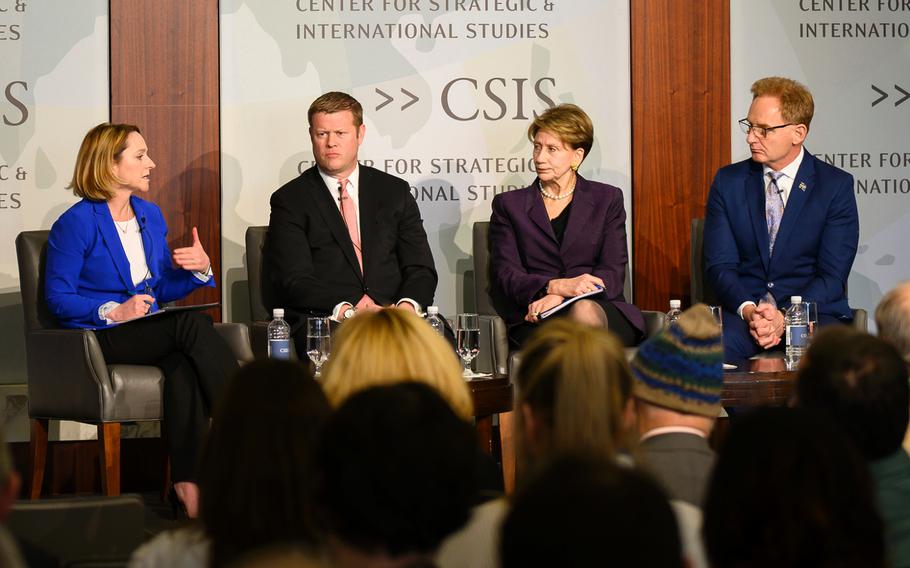
Kathleen Hicks, senior vice president of the Center for Strategic and International Studies, speaks as Army Secretary Ryan McCarthy, Air Force Secretary Barbara Barrett and acting Navy Secretary Thomas Modly listen during a tri-service discussion in Washington, D.C., on Feb. 21, 2020. (Alexander C. Kubitza/U.S. Navy)
WASHINGTON — The secretaries of the Army and Navy said Friday that they need to make difficult choices now to find budget savings or else fall short of the competitive force that the military needs for the future.
The services are dealing with growing demands to modernize their equipment, capabilities, and forces at the same time they are seeing budgets stagnate. The Army and Navy are reviewing programs in their budgets to find savings to reinvest in other ways.
“What I’ve told the department is we need to look internally first at ourselves to see where we can find savings within the way we traditionally do things to help fund that, before we can ask for anything more from the taxpayers,” acting Navy Secretary Thomas Modly said during a discussion at the Center for Strategic and International Studies, a D.C.-based think tank. Army Secretary Ryan McCarthy and Air Force Secretary Barbara Barrett also spoke about their services.
The Pentagon’s proposed budget for fiscal year 2021 is about $705.4 billion as the military falls in line with supporting the National Defense Strategy that seeks to prepare the United States for competition with China and Russia. The Pentagon’s budget would allocate $178 billion for the Army, $207.1 billion for the Navy and Marine Corps, $191.8 billion for the Air Force and $15.4 billion for the Space Force.
Defense Secretary Mark Esper and Army Gen. Mark Milley, chairman of the Joint Chiefs of Staff, will defend their budget proposal Wednesday before the House Armed Services Committee. Modly will defend the Navy’s proposed budget before the committee on Thursday.
The Army has about 40% of its budget slated for modernizing its force, McCarthy said, challenges service leadership to find a balance between investing in new capabilities and divesting from legacy programs.
“The underlying theme here is you got to have the will to look at Congress in the face and tell a member where they make a product in their district, that we don’t need it anymore,” he said. “But here’s the opportunity that’s going to exist for that manufacturer.”
The Navy’s 2021 budget proposal buys less ships and puts them behind in attaining the required 355 ships by 2030. Modly said he believes they can still get to that number or higher in 10 years by finding $40 billion in savings by 2026 as part of their “Stem to Stern” review, which was announced Tuesday.
The Navy now pays $2 billion per ship, a trend Modly said needs to be reversed. The Navy is considering to spend that money on more ships that are smaller and less expensive ships, and can be spread out to increase their presence around the globe, he said.
Barrett said the Air Force faces the same challenges and budget constraints as the Army and Navy, but she did not discuss efforts within the service to review program budgets to find savings. The Air Force is implementing reforms to their acquisition process to make it more efficient, she said, especially as the air and space technology that the service buys becomes more expensive.
The other big issue facing the Army and Navy are the costs associated with personnel, which continues to be a growing part of their budgets. The Navy is looking at unmanned ships or ships that need less personnel to operate, Modly said.
McCarthy said the Army is on a “collision course” in about 2023 with the cost of modernizing and growing the number of soldiers in order to reduce the strain of continuing deployments on the force.
“And I think that that’s where there’s going to be some very hard choices in front of us,” he said about finding savings. “Do we have to stop, do we have to adjust, do we get more topline, can we find more buying power.”
The Pentagon announced Feb. 13 that $3.8 billion from the services 2020 budgets has been reprogrammed to build the wall along U.S.-Mexico border. The service secretaries on Friday did not discuss how the funding to buy new ships, aircraft, or tactical vehicles is being diverted while they said they face growing demands to make investments in personnel and new equipment.
The issue is expected to be a topic at next week’s 2021 budget hearings after members of the House Armed Services Committee have already questioned the diversion of funds, including the chairman of the committee’s subpanel on readiness, Rep. John Garamendi, D-Calif., calling it “grossly irresponsible.”
Kenney.Caitlin@stripes.com twitter: @caitlinmkenney